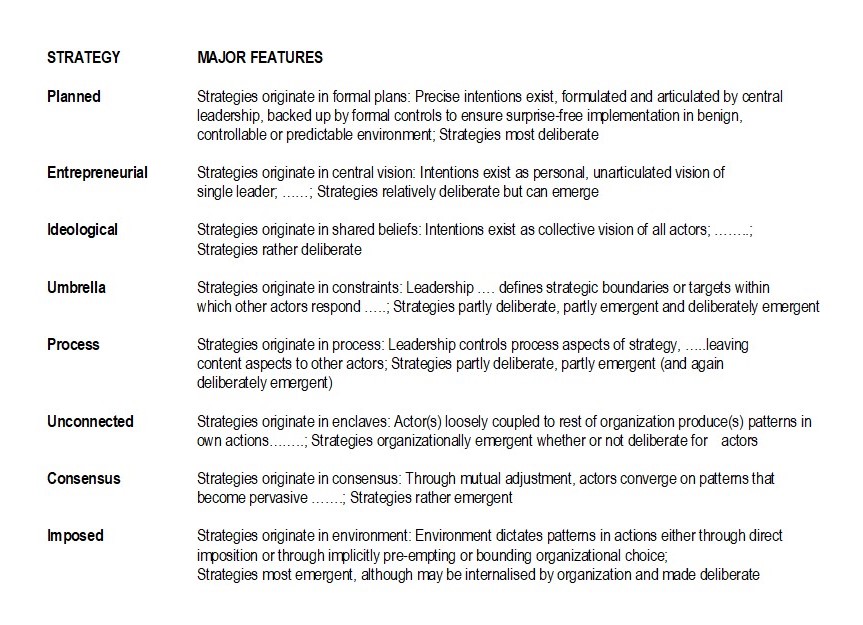and a classification of strategic drivers
Revisiting organisational strategic management (Part 3)
SERIES ARTICLE
By Alan Stretton, PhD (Hon)
Sydney, Australia
INTRODUCTION
This is the third of a series of articles which revisit some aspects of organisational strategic management – prompted, at least in part, by the current VUCA (Volatile, Uncertain, Complex, Ambiguous) environment which has been so dramatically exacerbated by the Covid-19 virus. To date we have discussed (in Stretton 2020l, 2020m):
- A recursive organisational strategic management model, and responsibilities for managing various stages;
- Augmenting the recursive strategic management model to help manage changes impacting outcomes and benefits
This somewhat exploratory article first looks at strategic drivers in the context of deliberate-to-emergent types, and then in another mode proposed by Booth 2018, which includes the internal or external origins of the drivers. I will also be introducing some new materials on strategic drivers from other sources, to try and build up a kind of checklist of types of strategic drivers which might be useful in dealing with the accelerated VUCA conditions of the Covid-19 era.
DELIBERATE, EMERGENT, INTERNAL & EXTERNAL STRATEGIC DRIVERS
Mintzberg & Waters’ strategic continuum from “deliberate” to “emergent”
As I first discussed in Stretton 2017k, Mintzberg & Waters 1985 had the following to say on the results of ten years of researching the process of strategy formation.
Comparing intended strategy with realized strategy, as shown in Figure 1, has allowed us to distinguish deliberate strategies – realized as intended – from emergent strategies – patterns or consistencies realized despite, or in the absence of, intentions.

Figure 3-1: Based on Mintzberg & Waters, Figure 1. Types of strategies
Their paper explores “the complexity and variety of strategy formation processes by refining and elaborating the concepts of deliberate and emergent strategy”. They say
Deliberate and emergent strategies may be conceived as two ends of a continuum along which real-world strategies lie.
Mintzberg & Waters identify eight strategies in this continuum, shown in a slightly abridged form in Figure 3-2.

Figure 3-2: Types of organizational strategies – derived from Mintzberg & Waters 1985 Table 1
It can be seen that the first three strategies are predominantly deliberate, in that they originate in formal plans. In a somewhat similar way, the last three strategies in Figure 3-2 are predominantly emergent, and are readily associated with projects that are initiated in more opportunistic or ad hoc ways. The remaining two strategies in the middle have substantial elements of both deliberate and emergent strategies. I have summarised these attributes in Figure 3-3 below.
More…
To read entire paper, click here
How to cite this paper: Stretton, A. (2021). Deliberate and emergent strategies, and a classification of strategic drivers; Revisiting organizational strategic management series (3); PM World Journal, Volume X, Issue I, January. Available online at https://pmworldlibrary.net/wp-content/uploads/2021/01/pmwj101-Jan2021-Stretton-Deliberate-and-emergent-strategies-and-classification-of-strategic-drivers.pdf
About the Author

Alan Stretton, PhD
Faculty Corps, University of Management
and Technology, Arlington, VA (USA)
Life Fellow, AIPM (Australia)
![]()
Alan Stretton is one of the pioneers of modern project management. He is currently a member of the Faculty Corps for the University of Management & Technology (UMT), USA. In 2006 he retired from a position as Adjunct Professor of Project Management in the Faculty of Design, Architecture and Building at the University of Technology, Sydney (UTS), Australia, which he joined in 1988 to develop and deliver a Master of Project Management program. Prior to joining UTS, Mr. Stretton worked in the building and construction industries in Australia, New Zealand and the USA for some 38 years, which included the project management of construction, R&D, introduction of information and control systems, internal management education programs and organizational change projects. He has degrees in Civil Engineering (BE, Tasmania) and Mathematics (MA, Oxford), and an honorary PhD in strategy, programme and project management (ESC, Lille, France). Alan was Chairman of the Standards (PMBOK) Committee of the Project Management Institute (PMI®) from late 1989 to early 1992. He held a similar position with the Australian Institute of Project Management (AIPM), and was elected a Life Fellow of AIPM in 1996. He was a member of the Core Working Group in the development of the Australian National Competency Standards for Project Management. He has published over 200 professional articles and papers. Alan can be contacted at alanailene@bigpond.com.au
To see more works by Alan Stretton, visit his author showcase in the PM World Library at http://pmworldlibrary.net/authors/alan-stretton/.









